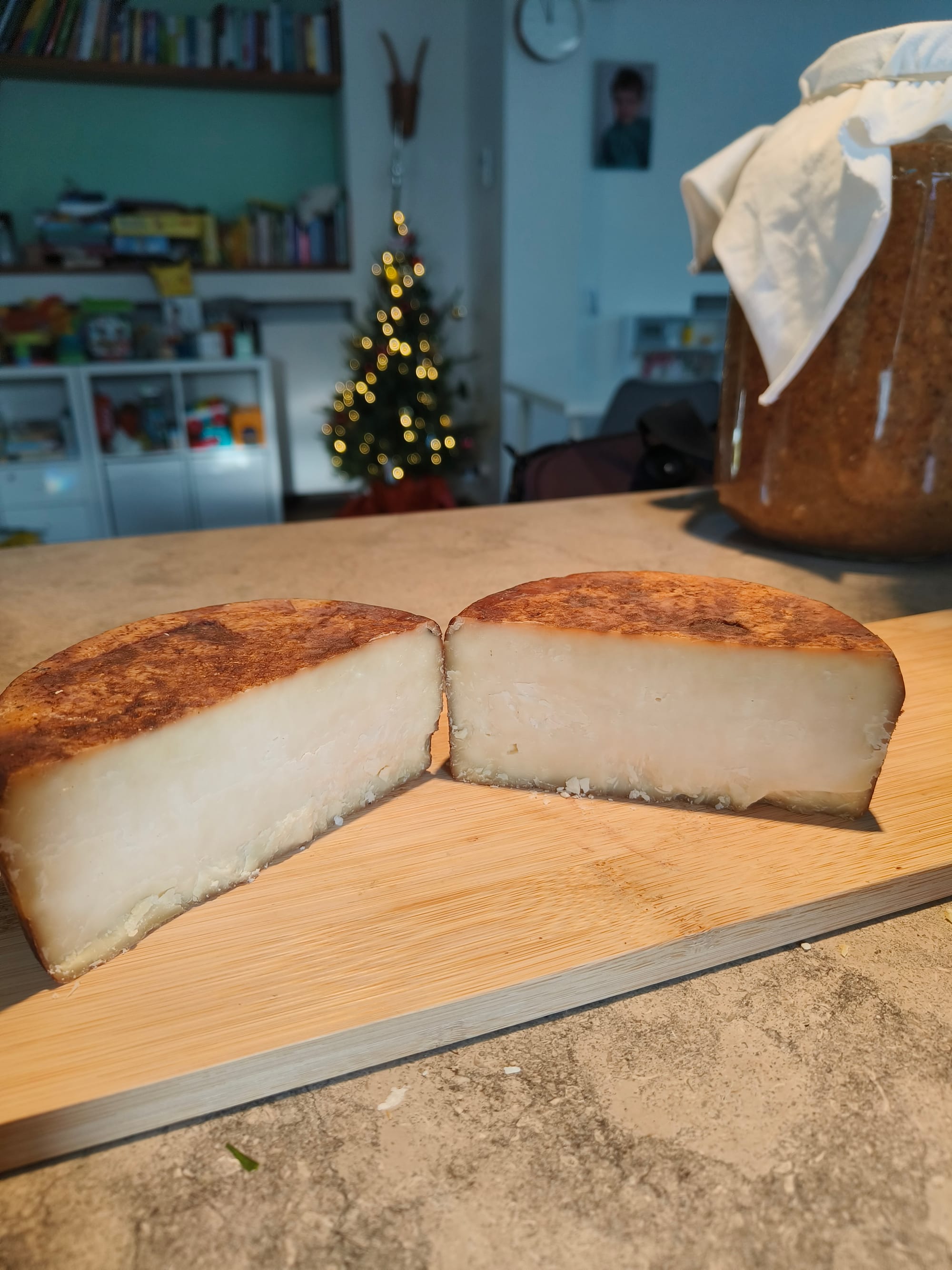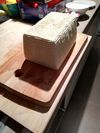Experiment #9 - affinage - Balsamic Vinegar - Aceto Balsamico di Modena IPG cheese
Aceto Balsamico di Modena IPG cheese combines the tangy sweetness of Modena's renowned balsamic vinegar with creamy cheese. This delightful fusion offers a unique blend of flavors, perfect for adding a gourmet touch to salads, appetizers, or cheese platters.

Balsamic Vinegar, known also as Aceto Balsamico Tradizionale di Modena IPG is well-known an Italian traditional vinegar created through the long and natural aging of cooked must from Modena grapes inside small barrels. These barrels were traditionally kept by families in the attics of their homes.
Deep and intense dark brown in colour and with syrup-like density. It is made from cooked grape must, matured by slow acetification, derived from natural fermentation and progressive concentration, by means of very long aging in series of vats (casks) of different sizes and woods. It is characterized by a complex, penetrating aroma, with a balanced acidity touch.
Combining the Aceto Balsamico's penetrating aroma with cheese is definitely a balancing act, if well done it may turn a good cheese into an unforgettable one.
Table of contents
- Goal and personal considerations about this experiment
- Complexity and commitment assessment
- Process scheme
- Human factor assessment
- Stuff you will need
- The process
Goal and personal considerations about this experiment
being able to create a new recipe by using Aceto Balsamico di Modena to refine a caciotta cheese.
This experiment will focus on creating the right aging environment to make sure the Aceto's punch doesn't overrule the caciotta's mild taste.
In this case the bath was made (you may have guessed it already) with plain and simple Aceto Balsamico di Modena IGP.
The most tricky part of this experiment was understanding when to pull the cheese out from the bath to finalise the aging.
Complexity and commitment assessment
| Complexity | medium/high |
| Time required | day 1: roughly 4/6 hours (with several pauses in between). day 2: 30 minutes. Day 3-33: you will need to flip the cheese once per day Day 34-41:turn the cheese every 2/3 days Day 41-42: perform dry-salting - 30 minutes turning the cheese daily afterwards. |
Process scheme
| Process step | Duration |
| Curdling, steaming, acidification | 1 day |
| Brining | 8 hours/kg |
| Plain aging | 30 days |
| Bath in Aceto Balsamico | 7 days |
| Dry salting | 2 days |
| Drying/aging | 35 days |
Human factor assessment
| Patience required |
|
| things that can potentially please your partner/people around you |
|
| Things that can potentially upset your partner/people around you |
|
Stuff you will need:
for roughly 700g of cheese
| Uncommon stuff |
|
| Easy-to-get stuff |
|
| Optional stuff |
|
The process
Preparation
- clean all your material that will enter in contact with the milk - I use chlorine diluted in water - 4 ml/l
- prepare the water for the brine by boiling it and add the salt, let it cool down to room temperature, then refrigerate it to 12C
- if you are working with raw milk - pasteurize it by bringing it to 72C for 1 minute, then cooling it down with ice in a basin/kitchen sink
Heating and additions
- bring the milk to 40C - stir from time to time with a spoon
- add the yoghurt
- optional step: add the calcium chloride
Resting and coagulation
- put the lid on the pot and wait 30 min - optional step: cover the pot with a blanket to keep the temperature stable
- while stirring the milk, add the rennet and then stop the flow of the milk by putting the spoon crossway. Do not stir or shake the pot after this step. This will allow the rennet to form a thick curd.
- put the lid on the pot and wait 35 min - optional step: cover the pot with a blanket to keep the temperature stable
- test if the curd is thick enough by inserting a toothpick, if it stands on the curd, then it's time for the next step
Cutting and cooking the curds
- with a bread knife, cut the curd in squares of 5x5cm.
- put the lid on the pot and wait 15 min
- cut the curd with a wisk by moving it up and down until you get small pieces of around 1-2 cm
- cook the curd by bringing the curd to 43C (low fire) over low heat and slowly stirring for around 15 min
- turn off the heat and let the curd sink on the bottom for 15 min
Draining and flipping the curds
- by using a skimmer gently move the curd to the cheese mould(s) and let the curds drain
- you can keep the whey to make ricotta by bringing it to around 85C and adding citric acid.
- gently press the curd with the palm of the hand
- after 30 min carefully flip the curd on the cheese mould. This can be done by holding one side with the palm of the hand and rapidly flipping it
Steaming, flipping the curds and brining
- steam the curds by adding a little bit of hot water (a thin layer is enough, it needs to generate some steam) and put the curd (inside the mould) in a container and close the lid. Steaming will allow draining the whey and let the pH drop. Make sure the curds do not enter in contact with the whey that accumulates on the bottom of the chamber (that's why a support of the cheese mould is needed)
- try keeping the temperature of the steaming chamber around 30C (as constant as possible) and high humidity (95%), this can be done by just leaving the chamber inside an oven.
- flip the curds after 30, 60, 90, 120 min in the mould and add every time a little bit of hot water to keep the humidity high
- leave the cheese curd at 10-12C for about 18 hours/1 day to let the pH drop to (5.2 - 5.4).
- leave the cheese 6h/kg for the brining.








The Aceto Balsamico cheese key process steps
Aging
- The aging temperature should be 12C, 70% humidity.
- flip the cheese daily for 30 days.
- leave the cheese in a leakproof container with the Aceto Balsamico di Modena IGP. Close the lid and leave the container at 12C for 7 days.
- every 2-3 days flip the cheese inside the container.
- after thwe bath dry salt the cheese by applying the half of the salt on one side, wait 24 hours and apply the rest of the salt on the other side.
- let the cheese dry and age for 35 days.
Eating
- the Aceto Balsamico cheese is edible right after the aging, the crust is not edible.









the affinage moments of this wonderful Aceto Aceto Balsamico di Modena IGP cheese
